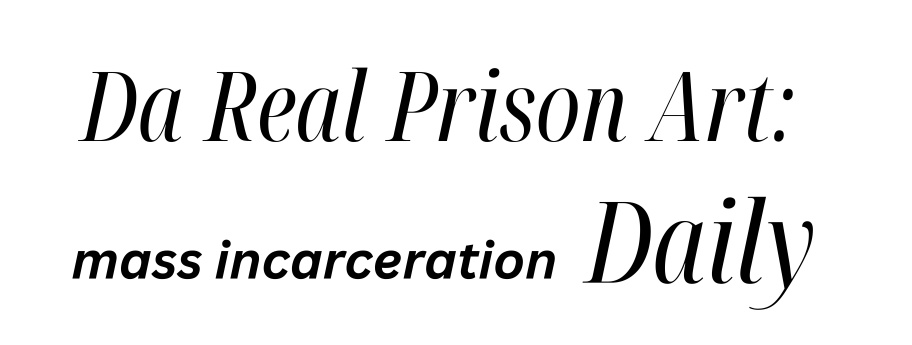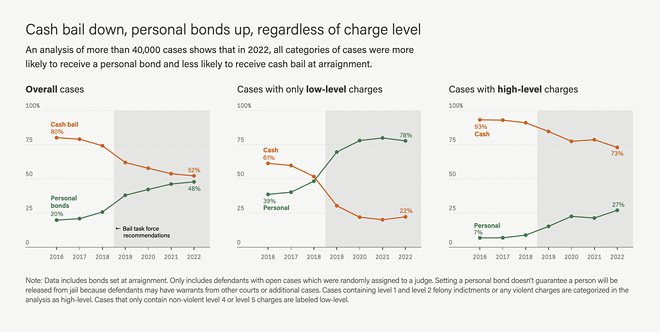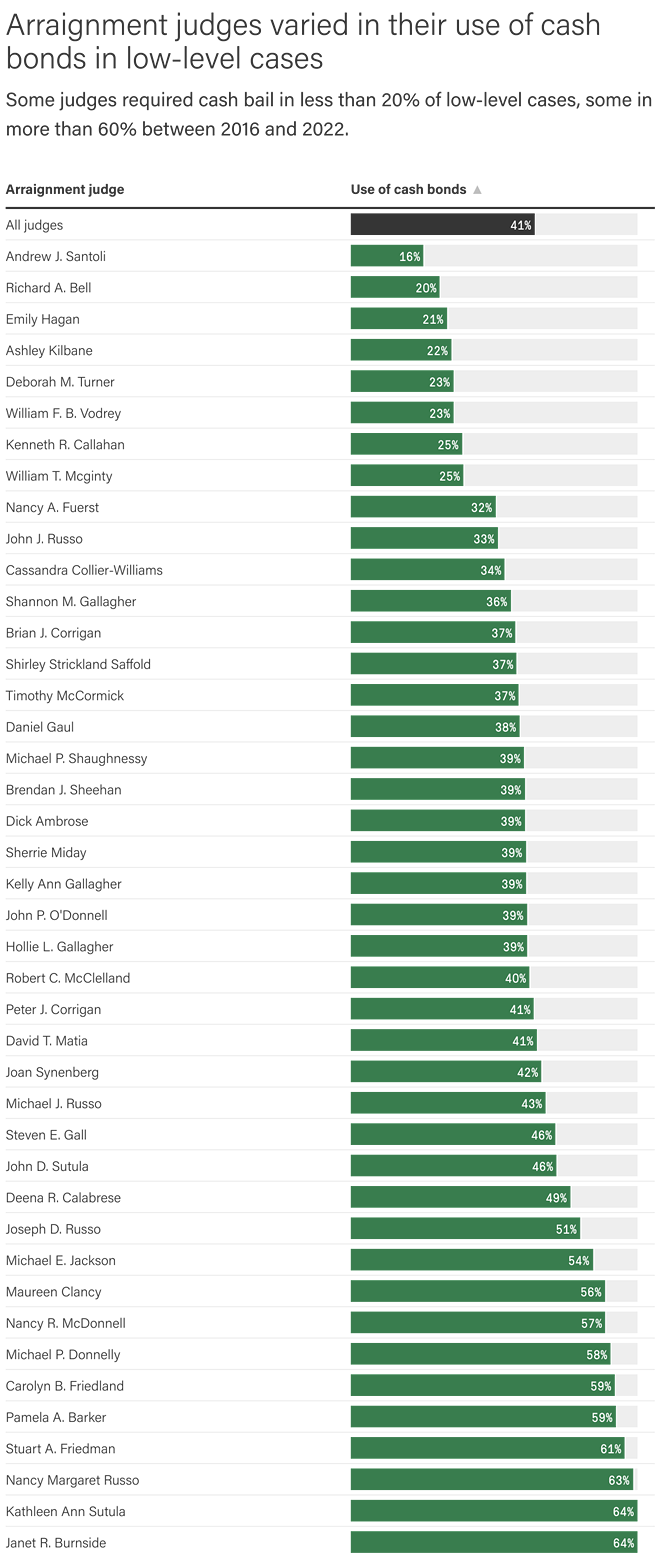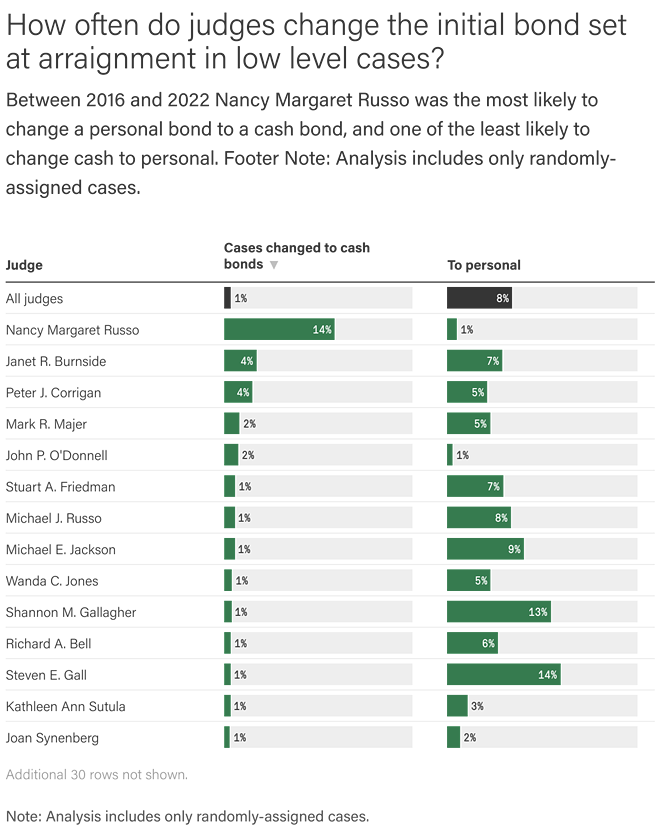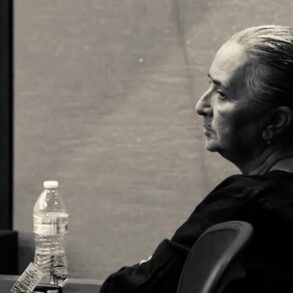This article was published in partnership with The Marshall Project, a nonprofit news organization covering the U.S. criminal justice system. Sign up for their newsletters, and follow them on Instagram, TikTok, Reddit and Facebook.
In recent years, the Cuyahoga County court system has drastically cut its use of cash bail. That means fewer people sit in jail while awaiting trial.
The shift followed calls to dismantle a bail process that created a two-tier system: one for those who could pay for their freedom and one for those who could not. Local and national reports showed those who could not were most often poor or Black.
The Marshall Project reviewed the bail decisions Cuyahoga County judges made in nearly 70,000 felony cases filed between 2016 and 2022 to understand how their bail practices had changed. Overall, judges are now setting cash bail in felony cases far less frequently and are more often setting personal bonds — which don’t require payment for release.
Defendants can post cash bail with a surety bond, property bond, or a 10% deposit or the full amount, depending on what the judge orders for the case.
To improve the bail-setting process, the court zeroed in on a few key decision points.
Instead of implementing more controversial or sweeping reforms — changes to state laws, formal court rules or an expensive overhaul of the county’s pretrial services — county justice officials say they have changed their culture and practices. Because the changes to the bail process are largely informal, it is unclear whether they’ll last.
Common Pleas judges now review felony cases more quickly, an effort put in place to level out the uneven bail set in the county’s 13 municipal courts. Since 2016, judges who handle felony arraignments have also cut their use of cash bonds from about 80% to just over half of all randomly assigned cases, where defendants did not already have a case open with the court. In other words, at this stage, judges set personal bonds in nearly half of all cases in 2022.
County justice system officials have directed most of their efforts toward releasing more defendants facing low-level and non-violent felony charges. The court’s bond commissioner now routinely recommends that judges set personal bonds instead of cash in most of these cases, which account for about 30% of felonies each year. Judges have also increased their use of electronic and in-person monitoring for defendants who are released.
However, personal bonds don’t automatically mean a defendant is released from jail if they have other criminal cases or face a probation or parole violation. And many defendants — more than half in 2022 — were able to post bonds that required money to be released. Judges still have the final say about bail in each case — the state’s constitution requires them to consider public safety — but bail still varies significantly based on the judge making the decision. Some judges set cash bail in less than 20% of low-level felony cases, while others required it more than 60% of the time.
Administrative and Presiding Judge Brendan Sheehan said in an emailed response that The Marshall Project’s findings affirm his philosophy that people should not sit in jail because they cannot afford to post bond. Sheehan also expressed concern about comparing judges’ records on bail given that each case has a unique set of facts. “Judicial discretion and judicial philosophy also come into play under our system of law,” he wrote.
In reporting this piece, The Marshall Project shared findings with and asked for comment from current court officials, as well as the current and former judges named in this article.
Without a close look at the changes made to bail practices, the impact of the reforms on public safety is easily misunderstood.
Changes in bail practices can directly affect how many people are held in jail or released into the community on any given day. They can also stir up anxieties — whether grounded in truth or not — about public safety.
This summer, residents have packed county meetings to demand that officials invest their money in affordable housing, mental health response and other social supports that could prevent people from arrest in the first place rather than spending $750 million or more on a new suburban jail facility that would house hundreds more than the current one downtown.
Cleveland has also experienced an uptick in homicide, robberies and aggravated assaults in recent months. Cleveland’s violent crime rate has been one of the highest among U.S. cities for years. But overall crime rates have not spiked dramatically in the past decade. The number of felony cases in the county has remained stable at about 12,000 a year.
Still, public pressure to address public safety has increased for elected officials, including Cleveland Mayor Justin Bibb. The mayor initially pointed the finger at local judges, saying they were releasing too many repeat defendants or people charged with gun-related crimes. Bibb has since backed off of those claims, instead directing blame at state lawmakers’ efforts to relax gun laws.
The overall use of cash bonds has decreased — with a few exceptions.
When people were charged with crimes such as drug possession or theft, more than 60% of their cases in 2016 received a cash bond. By 2022, this dropped to just over 20%.
Judges almost always set cash bonds in murder cases, The Marshall Project found. People charged with firing a gun in a park, near a school or into a home were also more likely to receive a cash bond. And in cases where a person was accused of illegally carrying or possessing a gun, bail decisions were more split between personal and cash bonds.
For other high level felonies, such as felonious assault, the rate of cash bonds decreased from more than 90% of cases in 2016 to just over 70% of cases in 2022.
Bail decisions are heavily affected by which judge is sitting in the arraignment room on a given day.
In Cuyahoga County, judges take turns setting bail in felony cases during arraignment, after a person is indicted by a grand jury.
The Marshall Project analyzed the decisions of arraignment judges in over 40,000 randomly assigned cases, from 2016 through 2022. These include more than 14,000 low-level felony cases. Low-level cases included only 4th and 5th degree felony charges and no charges that Ohio considers violent, such as assault.
The judge assigned to the arraignment room can make a big difference in whether people receive a personal or cash bond — even when they face similar charges. By 2022, the difference in individual judges’ use of personal bonds narrowed.
For example, Judge Andrew Santoli, who was first elected in 2020 when reforms were already underway, set the fewest cash bonds during his stretches in the arraignment room — less than 20% of the low-level felony cases he arraigned.
By contrast, Judge Janet Burnside, who retired in 2019 and is now a visiting judge, Judge Kathleen Ann Sutula and Judge Nancy Margaret Russo set cash bonds most often during arraignments of low-level cases. From 2016 through 2022, each of the three judges set cash bonds in more than 60% of their low-level cases. Both Judge Russo and Judge Sutula reduced their use of cash bonds after 2019 for low-level cases.
Arraignment judges were more consistent in their bail decisions in high-level felony cases. A little over 25 percentage points separated the judge who set cash bonds most often and the arraigning judge who set them least often. High-level cases included 1st and 2nd degree felonies or any charge for a violent crime.
Not all cases are randomly doled out to judges. Cases are manually assigned to a judge when a person already has an open felony case or is on probation. Those cases go to the judge already handling the previous case or cases. The Marshall Project reviewed 26,000 manually-assigned cases and saw a decrease in the use of cash bail, but not to the same extent as randomly assigned cases. In general, new criminal charges would be a violation of bail conditions or probation.
On rare occasions, judges will change the bail set during arraignment once they are assigned to a case.
The bail set when a person is arraigned on a felony charge is important. In 90% of cases, the judge picked to handle the case didn’t change that bail at all before the case ended.
But judges do have discretion to revisit bail at any time. Most often that happens when a prosecutor or defense attorney makes a request to raise or lower the bail, or if a defendant doesn’t show up for a hearing or follow rules set by the court.
It was rare for a judge to change a personal bond to a cash bond — which would require the defendant to pay for release — directly following an arraignment. That happened in just over 1% of all cases from 2016 through 2022, The Marshall Project found.
Many of the switches from personal to cash bonds in low-level cases can be attributed to Judge Nancy Margaret Russo, who did that more often than any of the other 44 judges who presided over at least 50 low-level cases.
Russo told The Marshall Project that she views bonds as fluid. She doesn’t oppose personal bonds, but does review bail for cases assigned to her and places nearly every defendant released on bond — personal or cash — on supervised release. That can lead to more changes in bail if they miss an appointment or fail a drug test. “I’m looking for them to demonstrate to me, ‘Look, I can trust you in the community,” she said.
The more common change was from cash bond to a personal bond, which happened in over 400 low-level cases — about 8% of the time. This was roughly the same rate as in high-level cases, though those frequently came with court supervision or other conditions on release.
Judge Michael Donnelly, who is now an Ohio Supreme Court Justice, and Judges Steven Gall and Michael Shaughnessy were most likely to make this change for low-level cases. Defendants whose cases were accepted into one of the court’s diversion programs, which can help people avoid a conviction, were the most likely to have a cash bond changed to a personal bond.
Bailing out defendants still costs millions of dollars a year in Cuyahoga County.
The amount spent on bail has decreased since 2016 when defendants posted over $35 million. Last year, the total dropped to about $30 million, with cases of Black defendants representing roughly $23 million of the total.
The decline is the result of a few changes to bail practices. Overall, judges set cash bail for cases less often. They also more frequently exercised their option to allow defendants to pay only 10% of the bail amount to be released from jail.
Surety bonds, which are posted mainly by bail bond companies, made up the largest share of the amount posted. In 2022, more than 95% of the value posted came from surety bonds.
Though judges are setting cash bail less, when they do, the amount is often higher. This change is likely the result of judges setting more personal bonds in cases where they previously set cash bail in low amounts.
Between 2016 and 2022 the median cash bail set and then posted in a case has:
- Increased from $5,000 to $10,000 overall.
- Increased $3,500 to $5,000 in low-level cases.
- Remained steady at $10,000 in the two highest level felony cases.
The increased use of personal bonds hasn’t entirely eliminated the system’s racial disparities.
Judges’ bail practices contributed to racial disparities in the overall system, a report by the ACLU of Ohio found. In 2020, the ACLU released findings from their analysis of cash bail decisions for felony cases in Cuyahoga County for a two-year period ending on June 30, 2019.
The disparities begin with arrest and charging decisions made by police and prosecutors, and continue with differences in how often judges set personal bonds for White and Black defendants. During the review period, a third of all White defendants received a personal bond compared to fewer than a quarter of Black defendants, the ACLU found. The Marshall Project found that in 2022, the roughly 10 percentage point gap between Black and White defendants receiving personal bonds persisted. At arraignment hearings, judges set personal bonds in about 45% of Black defendants’ cases, compared to 55% of White defendants’ cases.
The ACLU also looked specifically at certain drug crimes. In those cases, Black defendants received personal bonds just over a third of the time, compared to nearly half of White defendants. In 2022, the bail gap closed for these crimes. Black people charged only with drug possession or manufacturing received a personal bond at nearly the same rate as White defendants, at over three-quarters of the time for both groups.
The court’s sweeping changes to the bail process has not alleviated overcrowding in the county’s downtown jails.
That is partially a result of a backlog of more complex cases from 2020 and 2021 when the pandemic halted jury trials. In addition, the majority of people held in the jail currently are facing charges for violent crimes, court officials said.
However, the share of people held in jail while facing low-level charges has declined in recent years. In 2019, people with low-level charges made up more than 20% of the jail population. On Aug. 21, about 12% of people were held in the county’s jail on a low-level felony, according to the court.
Overcrowding is a decades-old problem in Cuyahoga County. The current jail building, which was constructed in the 1970s, was meant to house 886 people. In the 1990s, a second jail was added, expanding the jail’s capacity to hold about 1,400 people.
Additional beds have not alleviated the overcrowding. The county, at times, has had to pay suburban jails to house defendants. And by 2018, the county’s downtown jails were once again dangerously overcrowded. As many as 2,400 people were crammed into spaces that could hold no more than 1,880. The pressure to address the unequal bail system intensified as conditions in the county jail worsened and more people held in the jail died from overdoses, medical issues and violence.
The COVID-19 pandemic temporarily decreased the jail population to around 900 people, but in recent months the population has hovered around 1,600 people a day.
Inconsistent bail decisions often began in the county’s 13 municipal courts.
As county leaders explored whether to reform the current bail and bond system, they looked into why bail amounts were highly inconsistent, even for defendants who faced similar charges. Much of it was rooted, they found, in decisions made in the 13 municipal courts, where bail is often first set after a felony arrest.
“A suspect arrested on the same charge in one part of town may end up with a bond many times higher than if he had been arrested in another area,” the Cuyahoga County Bail Task Force said in a 2018 report. The task force recommended that all of the courts in the county use the same standard to set bail from the moment of arrest, regardless of where an arrest happened. Efforts to standardize the process stalled.
It is not possible to measure the overall change in cash bail set in felony cases at the municipal court level using the county court data. Municipal bail decisions were not recorded on the county court’s public docket for over half of all felony cases because Cuyahoga County prosecutors don’t provide that information to the court’s clerk in cases they took directly to a grand jury for indictment.
Cleveland Municipal Court Judge Michelle Earley said the court’s overall use of cash bonds, including in felony and misdemeanor cases, decreased significantly since the court started using new bail assessment tools. Earley said that since mid-2020, police and prosecutors now take low-level cases directly to a grand jury so bail isn’t set until a county arraignment. That means the municipal court mostly sets bail in high-level cases where a person was arrested and is being held in jail.
The Marshall Project did analyze bail patterns for the 40% of felony cases that municipal courts transferred to the Common Pleas court, which included bond information. The overall use of cash bonds in those cases decreased from about 90% to a little over 70%.
Subscribe to Cleveland Scene newsletters.
Follow us: Apple News | Google News | NewsBreak | Reddit | Instagram | Facebook | Twitter | Or sign up for our RSS Feed
This post was originally published on this site be sure to check out more of their content.
